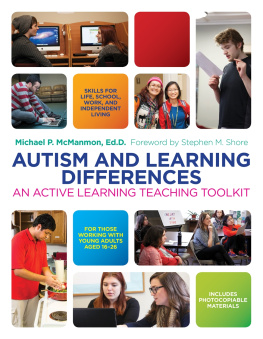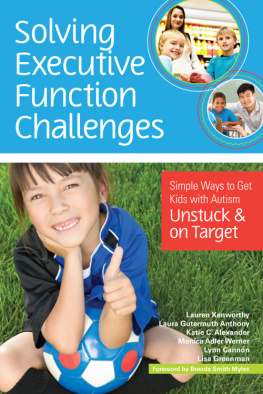Table of Contents
List of tables
- Tables in Chapter 6
- Tables in Chapter 8
List of illustrations
- Figures in Chapter 2
- Figures in Chapter 3
- Figures in Chapter 4
- Figures in Chapter 5
- Figures in Chapter 6
- Figures in Chapter 7
- Figures in Chapter 8
Landmarks
Table of Contents
Flexible and Focused
Teaching Executive Function Skills to Individuals with Autism and Attention Disorders
Adel C. Najdowski
Psychology Department, Pepperdine University, Los Angeles, CA, USA
Critical Specialties in Treating Autism and Other Behavioral Challenges
Series Editor
Jonathan Tarbox

Copyright
Academic Press is an imprint of Elsevier
125 London Wall, London EC2Y 5AS, United Kingdom
525 B Street, Suite 1800, San Diego, CA 92101-4495, United States
50 Hampshire Street, 5th Floor, Cambridge, MA 02139, United States
The Boulevard, Langford Lane, Kidlington, Oxford OX5 1GB, United Kingdom
Copyright 2017 Elsevier Inc. All rights reserved.
No part of this publication may be reproduced or transmitted in any form or by any means, electronic or mechanical, including photocopying, recording, or any information storage and retrieval system, without permission in writing from the publisher. Details on how to seek permission, further information about the Publishers permissions policies and our arrangements with organizations such as the Copyright Clearance Center and the Copyright Licensing Agency, can be found at our website: www.elsevier.com/permissions.
This book and the individual contributions contained in it are protected under copyright by the Publisher (other than as may be noted herein).
Notices
Knowledge and best practice in this field are constantly changing. As new research and experience broaden our understanding, changes in research methods or professional practices, may become necessary.
Practitioners and researchers must always rely on their own experience and knowledge in evaluating and using any information or methods described herein. In using such information or methods they should be mindful of their own safety and the safety of others, including parties for whom they have a professional responsibility.
To the fullest extent of the law, neither the Publisher nor the authors, contributors, or editors, assume any liability for any injury and/or damage to persons or property as a matter of products liability, negligence or otherwise, or from any use or operation of any methods, products, instructions, or ideas contained in the material herein.
ISBN: 978-0-12-809833-2
British Library Cataloguing-in-Publication Data
A catalogue record for this book is available from the British Library
Library of Congress Cataloging-in-Publication Data
A catalog record for this book is available from the Library of Congress
For Information on all Academic Press publications visit our website at https://www.elsevier.com

Publisher: Nikki Levy
Acquisition Editor: Emily Ekle
Editorial Project Manager: Barbara Makinster
Production Project Manager: Stalin Viswanathan
Designer: Mark Rogers
Typeset by MPS Limited, Chennai, India
Series Foreword: Critical Specialities in Treating Autism and Other Behavioral Challenges
Series Editor
Jonathan Tarbox, PhD, BCBA-D, FirstSteps for Kids, University of Southern California, Los Angeles, CA, United States
Purpose
The purpose of this series is to provide treatment manuals that address topics of high importance to practitioners working with individuals with autism spectrum disorders (ASDs) and other behavioral challenges. This series offers targeted books that focus on particular clinical problems that have not been sufficiently covered in recent books and manuals. This series includes books that directly address clinical specialties that are simultaneously high prevalence (i.e., every practitioner faces these problems at some point) and yet are also commonly known to be a major challenge, for which most clinicians do not possess sufficient specialized training. The authors of individual books in this series are top-tier experts in their respective specialties. The books in this series will help solve the problems practitioners face by taking the very best in practical knowledge from the leading experts in each specialty and making it readily available in a consumable, practical format. The overall goal of this series is to provide useful information that clinicians can immediately put into practice.
The primary audience for this series is professionals who work in treatment and education for individuals with ASD and other behavioral challenges. These professionals include board certified behavior analysts (BCBAs), speech and language pathologists (SLPs), licensed marriage and family therapists (LMFTs), school psychologists, and special education teachers. Although not the primary audience for this series, parents and family members of individuals with ASD will find the practical information contained in this series highly useful.
Dr. Jonathan Tarbox is the Program Director of the Masters of Science in Applied Behavior Analysis (ABA) program at the University of Southern California, as well as Director of Research and a Regional Clinic Director at FirstSteps for Kids. He is Associate Editor of the journal Behavior Analysis in Practice and serves on the editorial boards of five major scientific journals related to autism and behavior analysis. He has published 2 books on autism treatment and well over 70 peer-reviewed journal articles and chapters in scientific texts. His research focuses on behavioral interventions for teaching complex skills to individuals with autism. He is a frequent presenter at autism and ABA conferences worldwide, and a regular guest on television and radio.
Adel Najdowski, PhD, BCBA-D is an Associate Professor and Program Director of MS in Behavioral Psychology at Pepperdine University. Dr. Najdowski has provided ABA-based services to children with autism for 20 years. Between 2005 and 2010, she led the development of Skills, an online curriculum for children with autism. In 2014, Dr. Najdowski co-authored, Evidence-Based Treatment for Children with Autism: The CARD Model. She has over 40 publications in peer-reviewed journals, book chapters in scientific texts, and articles in popular media. Dr. Najdowski has served on the editorial boards of the Journal of Applied Behavior Analysis and Behavior Analysis in Practice and as a Guest Editor for a special issue in Research in Autism Spectrum Disorders. Her current research interests include teaching higher-order skills to children with autism and assessment and curriculum design for children with autism.
Chapter 1
Introduction
Abstract
The term executive function is traditionally used to refer to the chief operating system located in the prefrontal region of the brain, which is used to engage in cognitive processes required for goal-directed behavior. Some common executive function processes used for goal-directed behavior include self-awareness, inhibition, self-management, attention, organization, problem solving, time management, planning, working memory, emotional self-regulation, and flexibility. This chapter defines executive function from both traditional and practical standpoints. Subsequently, it explains how this manual will help practitioners, educators, and parents teach executive function skills to individuals, from school-age to adults, with executive function deficits. All populations with executive dysfunction are included, such as autism spectrum disorder, attention deficit hyperactivity disorder, dyslexia, traumatic brain injury, and learning disabilities.














